Copyright 1996 by Bob Armstrong
Published in American Game Collectors Association,
Game Researchers' Notes,
Issue No. 25,
February-May 1997.
No two hand-cut jigsaw puzzles, cut separately, are exactly alike. As soon as the scroll saw blade cuts into the wood, subtle differences begin to emerge with the result that a piece from one puzzle will not fit properly into another[1] However, despite the fact that even identical pictures, hand-cut by the same maker one right after the other, differ in the shape of their pieces and the way they go together, consistencies in styles remain that can assist the collector in identifying the maker and era even when the original box is missing.
In this article, I propose a detailed system for analyzing and describing the cutting styles of hand-cut[2] jigsaw puzzles, with diagrams of sections from actual puzzles to assist collectors in analyzing their own puzzles. My objectives are to provide the basis for detailed classification and record-keeping of collections, to establish a common language by which collectors can "talk" to each other about their puzzles, particularly in the process of buying, selling and displaying their collections, and to focus attention on what the better cutters have achieved in making puzzles. Because of the unique nature of every individually hand-cut puzzle, no system will cover every style. Rather, I will analyze the more common styles employed in the United States over the past 150 years.
My analysis extends the work of earlier researchers, including AGCA members Anne Williams and Betsy and Geert Bekkering, who have studied cutting styles of American and European puzzles. Some puzzle manufacturers, most recently Stave Puzzles, have also described their own styles in company publications. See bibliography for specific references.
General Analysis of Cutting Styles
Basically, I analyze a jigsaw puzzle from five perspectives: the interlocking nature of the puzzle, the shape of the knobs (assuming it has knobs), the contour of the lines between knobs (or from piece to piece), the overall pattern created, and special techniques.
Interlocking. A puzzle is interlocking when most of it can be pulled along the table by a corner; it is semi-interlocking when only smaller sections slide together along the table; and non-interlocking when only the pieces touched will move. The term push-fit (p-f) is a synonym for non-interlocking and is most commonly used for describing (but not limited to) 1909 era puzzles.[3]
KnobsThe shape of knobs (also known as tabs, locks, or keys) comes in nearly limitless variations, depending upon the imagination and skill of the cutter.[4] For classification purposes, I define the major shapes as round, square, curve, curl, earlet (Stave puzzles calls this classic), foot, bulb, fantasy, [5] and random.
Classification must be based upon the predominant knob shape. Very few cutters can maintain only one shape throughout an entire puzzle -- a feat that distinguishes a truly fine cutter. Even that one shape will vary slightly within a puzzle and some of the knobs will not look quite "right" for easy classification.[6] Sometimes more than one shape will predominate, in which case the description should include all such shapes. When all else fails, I use the convenient classification of random.
Strange as it may sound, it can be difficult to distinguish between crooked (or bumpy) cutting from true knobs. The test I use is whether the cut results in an interlocking puzzle, at least in some degree. Knobs allow the cutter to saw essentially "chunky" or block-shaped pieces which would not interlock with each other but for their knobs. In the simplest sense, knobs change a non-interlocking style of cutting reminiscent of the 1909 era into an interlocking style reminiscent of the 1930s. [7]
Diagram 1: Knob Styles
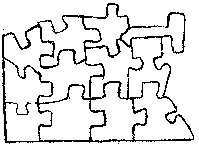 |
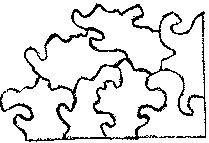 |
|
| 1a. round | 1b. square | 1c. curve |
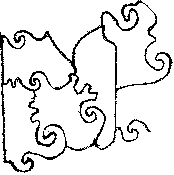 |
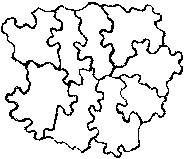 |
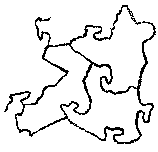 |
| 1d. curl | 1e. earlet (classic) | 1f. foot |
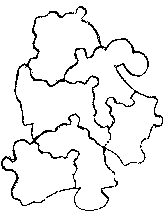 |
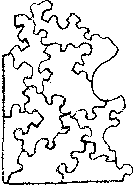 |
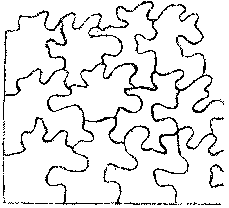 |
| 1g. bulb | 1h. fantasy | 1i. random |
Lines Within a puzzle, the contour of the lines between knobs, usually varies less than do the knobs themselves. For puzzles with no knobs, it is important to denote line contour type, and in my descriptions I specify contour whenever it is consistently straight, crooked, crescent, one-by-one (Stave uses nightmare), jagged, or angular.
Diagram 2: Line Styles
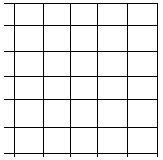 |
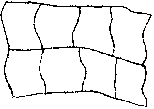 |
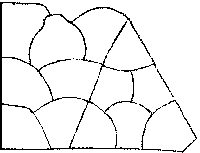 |
| 2a. straight (reduced in size) | 2b. crooked | 2c. crescent |
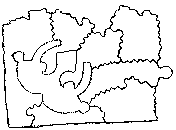 |
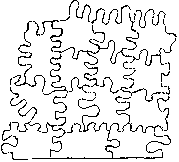 |
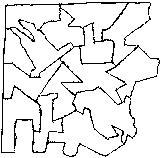 |
| 2d. jagged | 2e. 1-by-1 | 2f. angular |
Pattern. Two separate approaches to cutting puzzles create very different recognizable overall patterns which I describe as part of my analysis of cutting styles. The first approach is where the cutter consistently saws within a short distance of his/her previous cut without focusing on knobs. The result is usually longer, thinner pieces, or pieces with long, thin arms, distinctly different from the block or "chunky" shaped pieces associated with knob cutting. The choice of line contour combined with this approach creates recognizable overall patterns to the puzzle which I call long/angular, long/round, long/jagged, long/wavy, long/bumpy, long/foot, and scroll [see diag. 3]. Again, when all else fails, I use the term random to describe the pattern of some puzzles.
The more interesting and difficult-to-cut puzzles frequently contain these patterns. I find them interesting because of the unusual and/or aesthetically pleasing shapes of many of the individual pieces. To achieve these results a cutter must concentrate on sawing within a short distance of previous cut lines without becoming "trapped" and cutting back onto a line, not an easy task. While he/she can cut out individual pieces one by one in this fashion (see diags. 3a, 3b, 3c, 3d), a true expert will cut a section of a puzzle into a veritable maze of lines, all without cutting back onto a previous line, until the section is cut into two large pieces, one the negative of the other. That cutter will then cut across the "necks" of these two pieces in several places (see dotted lines in diag 3f). The more such cuts, the greater the number of final pieces, the more difficult and less interlocking the puzzle becomes. [8] It is this unusual cutting process, along with curls, which I define as the classic scroll style of the 1930s, cut under the brand names of Arteno, Jo-Jig, (early) Madmar, and several others. Unfortunately, manufactures have applied the term scroll to just about anything and their labels can not be relied upon to describe a puzzle as cut in diag. 3f.
Diagram 3: Pattern Styles
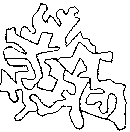 |
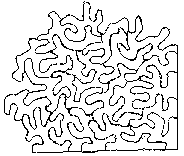 |
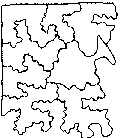 |
| 3a. long / angular | 3b. long / round | 3c. long / jagged |
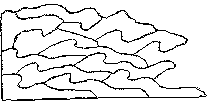 |
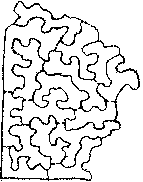 |
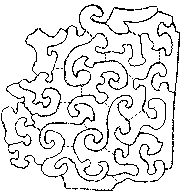 |
| 3d. long / wavy | 3e. long / bumpy | 3f. scroll |
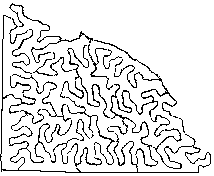 |
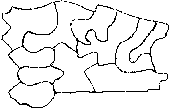 |
| 3g. long / foot | 3h. random |
The other approach is where the cutter saws a repetitive grid pattern back and forth and up and down across the puzzle, resulting in pices which look the same, much like diecut puzzles of today. This pattern (see diag 4) is called strip cut (also known as grid cut), and in the minds of most collectors is considered inferior. One wonders why the maker took the time to hand-cut the puzzle in the first place. Probably its because thats the easiest and least imaginative way to cut a puzzle and reflects the makers objective to produce one as quickly as possible. Straus and Victory puzzles are notorious for this. NOTE: A puzzle cut with this pattern in only one direction is called one-way strip cut (or ribbon cut).
In my opinion, it is the result, e.g., pieces which closely resemble each other in size and shape, that identifies a strip pattern. In a minor variation to this approach, a cutter can turn or "swing" the wood wider while feeding it into the saw blade. The result will be pieces which look more differentiated and interesting (see diag. 4c). Many early Straus puzzles were cut like this. Technically, they are strip cut, but I find the result significantly superior to later Straus and most diecut puzzles and prefer to label it variety strip cut to distinguish it from the more common strip cut. Compare diag. 4c with diags. 4a, 4b.
Diagram 4: Strip Cutting Styles
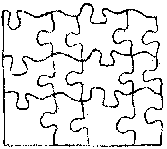 |
|
| 4a. strip (grid). see also 2a. |
4b. strip (ribbon). see also 2b. |
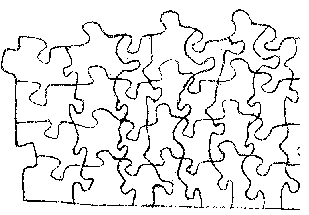 |
| 4c. stripcut with variety |
Special techniques clearly make a puzzle interesting, usually "the more, the better." The frequently used techniques of color-line cutting (clc) and figurals (figs) significantly increase the value of a puzzle and merit separate classifications by themselves. I identify a puzzle where color line cutting is employed only in certain areas as semi-clc, to distinguish it from puzzles where nearly every area is color line cut in the style of many 1909 era pushfits. However, when it comes to clc, more is not necessarily better. Many makers deliberately cut their puzzles semi-clc so as to make it more difficult for the assembler to adjust to the cutters style (Par puzzles for example). True (or near total) clc will also reduce the interlocking feature of a puzzle. To compensate, many cutters in the mid-1930s, including Pastime cutters, began to cut knobs along their color lines at regular intervals. If the test of a true interlocking puzzle is to be able to "pull it across the table," then nearly all puzzles cut without knobs along color lines are, at most, semi-interlocking, including the Pastimes cut before the mid-1930s. Most collectors tend to classify such puzzles as interlocking if they hold together just within their contiguous color areas. A reference to clc with interval knobs will clarify this.
The number of figurals in a puzzle is important (for examples of figurals, see diags. 1b, 2d, 2f, and 3c). Generally the greater the number, the higher the market value (although figurals will make a puzzle easier to assemble). But serious collectors are also interested in whether the figurals are:
- simple (cut without a pattern so as to look rough or even crude)
- complex (cut as multiple pieces within the pattern)
- interactive (relate to each other so as to create a scene or tableau)
- appropriate (relate to the picture in theme or location)
- personalized (names, dates, initials, references personal to the owner)
- enhanced (with lines cut into them)
- signature piece of cutter (e.g., the Par seahorse or Stave clown), often initialed on back
- another puzzle (e.g. pieces form a rebus)
True connoisseurs of figurals distinguish between Pastime, Webster, and Tuck figurals. Williams articles Parker Brothers Puzzling History and Depression Jigsaw Mania: the "Webster School" of Puzzle Cutting discuss and illustrate Pastime and Webster figurals.
Other special techniques include:
- irregular edges (especially if cut along color lines or to create a protruding figural)
- dropouts (holes deliberately left in the puzzle to confuse the assembler)
- sculpt (dropouts which form a figure by themselves or in conjunction with the picture)
- trick edges (two edge pieces which interlock only with an inside piece)
- inside (false) edges and corners (inside pieces cut to resemble edge or corner pieces)
- split corners (cut line starts at corner)
- split knobs (cut line goes through middle of knobs)
- two-sided puzzles (pictures, usually different, on both sides)
- multiple layer puzzles (sections of same or another picture cut and glued onto base puzzle)
- three-dimensional puzzles (e.g. foam-block puzzles popular today)
- two-way tricks ("double cutting" pieces to fit into more than one place)
I also like to describe whether a puzzle is stack cut (usually evidenced by tiny holes in the corners and middle of edges), well cut (a subjective judgment meaning that it "works well"), deceptive (the cut repeatedly misleads the assembler) and also whether it is particularly tight or loose with respect to its fit. [9] Finally, there are mistakes, the enemy of every collector of quality puzzles. Mistakes include a myriad of sins committed by cutters and are usually the mark an amateur. The major ones are:
- dead end cuts (indicating cutter started in a wrong direction and then backed out the blade)
- closed loops (cutter cut back onto a previous line creating a tiny piece)
- narrow necks (the necks of some knobs are too thin and prone to break)
- pen/ink marks on picture (where figurals were traced)
- inaccurate color line cutting (gross enough to defeat its purpose)
- slanted blade cuts (pieces fit together, but with difficulty and in only one direction)
Classification for Collections
Collectors vary, of course, in how much classification they want. But at a minimum, any serious jigsaw puzzle collector should identify his/her puzzles by the following four characteristics:
Interlocking? yes; semi; push-fit
Color Line Cut? yes; semi; no
Figurals? yes/no; how many
Strip cut? yes; one-way; no
Collectors who want to go to the next level should add Style as a category, and begin to list some of the names discussed above which best characterize the cut of the puzzle. Look for knobs first and if present, select one of the above knob-shape classifications. Then look for any distinctive contour of the lines between knobs or pieces, for a line classification. Finally, look for an overall pattern similar to one of the above pattern classifications. For example, most Straus and Victory puzzles are round knob. Par puzzles are earlets; jagged. Milton Bradley/Premier are usually long/jagged. Margaret Richardson is probably long/wavy, although some of her puzzles (cut by assistants?) belie this. Most 1909 era puzzles, especially Isabel Ayers, color line cut without knobs, are simply random. McLoughlin Brothers change style from edge to center and their puzzles are usually square knob edge/straight line center.[10] Madmar puzzles vary in style since they span over 50 years. Most of the earlier puzzles feature a scroll or long/round line contour, but later cutters began to emphasize knobs more. Tuck /Zag-Zaw are marked with earlets as the predominant knob shape. Parker Brothers/Jig-A-Jig are crooked line.[11]
And then there are Pastimes. Other than the earliest ones, Pastime puzzles are almost always interlocking or semi-interlocking with clc, and feature 12 figs per 100 pieces. General cutting style, however, obviously has varied over 50 years among many hundreds of cutters. Using numerous figural templates, the cutters focused on placing and cutting figurals within color sections as they cut each section piece by piece. The earliest puzzles tended to be less interlocking and more angular, but the cutters began inserting knobs between non-figural pieces within color line cut sections in the 1910s. Thus, an analysis of a Pastime puzzle will focus on the shape of the knobs and the contours between the knobs rather than the overall pattern of the cutting. I have found nearly all the knob shapes described above in Pastime puzzles (I havent seen fantasy), with earlets largely limited to the 1930s. Sometime in the 1930s, the cutters started inserting knobs (usually round) between color areas to increase the interlocking nature of their puzzles.
A truly elaborate level of classification adds a Comments category, to include further detail on the figurals and special techniques as outlined above. These comments will focus attention on a collections well cut puzzles, and ensure their value.
Conclusion
Hopefully, the results of this article will be a common language among collectors in describing the cutting styles of the puzzles within their collections, whether for sale, swap or show. In the process, a more complete description of a collection will help to increase its value. I would also suggest that a fuller understanding of cutting styles will lead to a deeper appreciation of puzzles cut by some of the lesser-known makers. Certainly, Pastimes are well cut puzzles. But they are not as intricately cut as some of those with overall patterns such as long/round, long/foot or scroll which deserve recognition as well. Discovering these puzzles and identifying their more obscure makers, or just simply assembling them, can only add to the joy of collecting jigsaw puzzles.
Acknowledgments
Special acknowledgment must be given to Anne Williams for her continuing support, information, and suggestions over the past six years, and to my son, Conrad Armstrong, a cutter himself, who made several key observations about the techniques employed in the 1930s. Finally, none of this would have been possible without my wife, Hildegard, allowing me to take over several rooms of our large house in Worcester, MA for the collection, restoration, study and display of puzzles.
References
Bekkering, Betsy and Geert. Piece By Piece: A History of the Jig-Saw Puzzle in the Netherlands. Amsterdam: Van Soeren & Co, 1988.
Kern, Evan J. Making Wooden Jigsaw Puzzles. Mechanicsburg, PA: Stackpole Books, 1996.
Roemer, Bernard J. "Production of Fine Picture Puzzles in the Home Workshop," PUZMAK Course in Puzzle Making and Selling. Colorado Springs, CO: The Puzzle Makers 1933.
Stave Puzzle Catalog 1996-1997. Norwich, VT: Stave Puzzles, Inc, 22-23.
Williams, Anne D. Jigsaw Puzzles--An Illustrated History and Price Guide. Radnor, PA: Wallace-Homestead Book Co, 1990.
Williams, Anne D. "Depression Jigsaw Mania: The Webster School of Puzzle Cutting." Game Times (April 1992) 352-53.
Williams, Anne D. "Parker Brothers Puzzling History," Game Times, Summer 1987, 122-23.
Footnotes
1. Pieces may be interchangeable between puzzles which are stack-cut together or within a puzzle which employs the special technique of double cutting. Diecut puzzles stamped out from the same die will have interchangeable pieces (although if the artwork has shifted in relationship to the die, the exchanged pieces may look askew).
[Back to text where this footnote appears.]
2. While the focus is on styles employed in hand-cut puzzles, much of my analysis applies to diecut puzzles as well.
[Back to text where this footnote appears.]
3. The term "1909 era" refers to the period from 1906 to 1910 when puzzles emerged commercially as a popular pastime for adults, especially in high society. Before then, puzzles were generally fewer than 75 pieces and intended for children. The solid wood used in early puzzles was prone to breaking along necks of knobs. While this did not materially affect the larger pieces of childrens puzzles, it did discourage including knobs -- and thus interlocking features -- in more finely cut adult puzzles, until plywood became readily available. Williams (1990, Ch. 1) presents an excellent account of the various phases in the history of jigsaw puzzles in the United States.
[Back to text where this footnote appears.]
4. Roemer (1933) illustrates (without naming) over 70 different knob styles. Kern (1996, p.17) shows 50 different knob styles (but again without naming them).
[Back to text where this footnote appears.]
5. Stave Puzzles uses fantasy in their brochures to describe a combination of diamond and semi-circle shaped knobs. It also applies to other combinations where the cutter is consistent and uses his imagination to create shapes other than the major ones listed above.
[Back to text where this footnote appears.]
6. The diagrams of actual puzzles show a less than perfect execution of some styles, especially knobs, e.g. round is not perfectly round and square is not perfectly square. In my view, they are "close enough," and I deliberately show them to assist the collector in classifying the large number of puzzles where the cutters have not executed quite up to our idealized definition.
[Back to text where this footnote appears.]
7. The 1930s feature the Depression puzzle craze which included a revival of hand-crafted wood puzzles noted for their knobs and interlocking style. See Williams (1990, pp. 13-17) for a more detailed discussion of this important era in jigsaw puzzle history.
[Back to text where this footnote appears.]
8. Pattern puzzles shown in Diag. 3 usually interlock to a considerable degree without knobs by their very complexity. However, to increase the interlocking nature of such puzzles when they have been cut into many smaller pieces, several cutters in the 1930s added "bumps" or knobs along their line cuts, resulting in a pattern which I call long/bumpy or even long/knobby (see Diag. 3e).
[Back to text where this footnote appears.]
9. Many collectors prize tight puzzles which can be lifted from the table and swung around by one corner. However, very tight puzzles are prone to damage, especially during disassembly in warmer, more humid weather. In loose puzzles, on the other hand, it is frequently difficult to determine where some pieces fit, a frustrating experience for the assembler. Looseness usually is the result of stack cutting with thick blades, again reflecting an objective to produce puzzles as quickly and cheaply as possible.
[Back to text where this footnote appears.]
10. Nineteenth century puzzles usually exhibit some form of straight or crooked line style, reflecting the simpler saws and slicing techniques used.
[Back to text where this footnote appears.]
11. The style of most diecut puzzles is clearly round knob. While I would also classify Consolidated Paper Box/Perfect puzzles as round knob, they frequently look like round bumps rather than knobs (although they still retain some interlocking feature). Tucos puzzles, until the 1950s, are crooked line. Some of Vikings Weekly Picture Puzzles have a round knob edge, pushfit center with figurals; some are simply pushfit throughout. Einson-Freemans Every Week combine square knobs with an angular feature.
[Back to text where this footnote appears.]
Makers of Puzzles Traced for Diagrams 1-4
| Diagram | Maker/Brand | Era | ||
|---|---|---|---|---|
| 1a. | round knob | Old Furniture Shop/Whileaway | 1930s | |
| 1b. | square knob | Charles Russell | 1970s | |
| 1c. | curve knob | Marjorie Stillman | 1930s | |
| 1d. | curl knob | Parker Brothers/Pastime | 1936 | |
| 1e. | earlet | Par | 1930/40s | |
| 1f. | foot | Parker Brothers/Pastime | 1930s | |
| 1g. | bulb | Parker Brothers/Pastime | 1940s | |
| 1h. | fantasy | Stave Puzzles | 1982 | |
| 1i. | random knob | unknown | 1930s | |
| 2a. | straight line | McLoughlin Brothers | 1890 | |
| 2b. | crooked line | University Dist. Co./Jig Wood | 1930s | |
| 2c. | crescent | I.B. Pierce | 1909 | |
| 2d. | jagged | Parker Brothers/Pastime | 1920s | |
| 2e. | one-by-one | Chester Nott | 1930s | |
| 2f. | angular | Parker Brothers/Pastime | 1910 | |
| 3a. | long/angular pattern | unknown | 1930s | |
| 3b. | long/round | unknown | 1930s | |
| 3c. | long/jagged | Milton Bradley/Premier | 1930s | |
| 3d. | long/wavy | Margaret Richardson/Perplexity | 1909 | |
| 3e. | long/bumpy | Mary Roberts/Arteno | 1930s | |
| 3f. | scroll | Arteno | 1930s | |
| 3g. | long/foot | Conrad Armstrong | 1994 | |
| 3h. | random pattern | unknown | 1930s | |
| 4a. | strip cut | Victory/Popular | 1950s | |
| 4b. | one-way strip cut | Victory/Popular | 1950s | |
| 4c. | strip cut with variety | Straus | 1930s | |